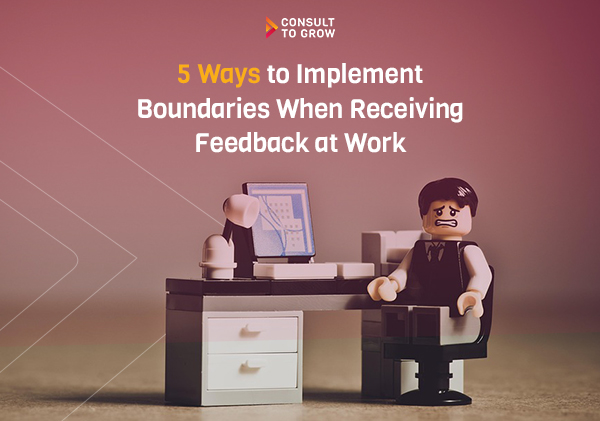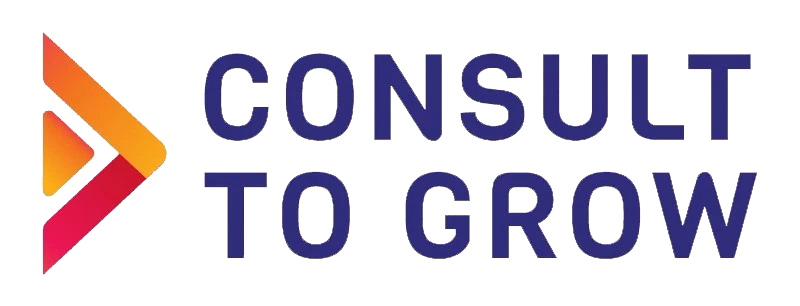Introduction
Congratulations on taking the exciting step towards becoming an independent consultant or freelancer! My name is Jamie Griffin, and I’ve been navigating the world of independent business consulting since 2016. Throughout my journey, I’ve encountered countless challenges, learned valuable lessons, and celebrated victories. Now, I’m thrilled to share my experiences and insights with you through our Gig Startup Fundamentals.

Here’s a sneak peek at what you’ll find:
Getting Started:
- Getting Set Up: Practical steps to launch your business.
- Marshalling Resources: How to gather the tools and support you need.
- Setting Rates: Strategies for pricing your services confidently.
Business Resources:
- Getting Clients: Proven methods for attracting and retaining clients.
- Doing the Work: Best practices for delivering high-quality results.
- Managing Time: Techniques to balance your workload and personal life.
Tools & Templates:
- Financial Tools: Essential resources to manage your finances.
- Client Agreements: Templates to ensure clear and professional engagements.
- Other Tools & Templates: Additional resources to streamline your operations.
In addition to the advice and resources found in this guide, I recommend exploring these valuable external resources:
- Small Business Administration (SBA) Business Guide: Comprehensive advice on planning, launching, managing, and growing your business.
- SCORE Simple Steps for Starting Your Business: A step-by-step program to help you achieve your business goals.
Freelancing offers immense freedom and flexibility, but it also comes with its own set of challenges. My goal with this post is to equip you with the knowledge and tools to overcome those challenges and thrive in your freelance career.
Remember, every successful freelancer started exactly where you are now. Embrace the learning curve, stay persistent, and don’t hesitate to reach out for support along the way. Welcome to the world of freelancing – your adventure begins now!
Before we begin, if we had lawyers, we think they’d want us to say the following: The information provided in this post, including tools, templates, and guidance, is for general informational purposes only and does not constitute legal, financial, or tax advice. Consult with a licensed attorney, accountant, or other qualified professional familiar with your specific circumstances before making any decisions or taking action based on the content provided.

What is a freelancer or independent consultant?
Freelancers and independent consultants work on a contract basis for a variety of companies, as opposed to working as an employee for a single company. Freelancers are often considered to be self-employed and have the freedom to pick and choose their projects and the companies they like to be associated with. Some of the most common freelance jobs include:
- Consulting
- Writing
- Graphic and Web Design
- Internet Specialists (SEO, Social Media, Internet Security)
- Photography
- Customer Service
- Administrative Support
Since you may work as an independent contractor or hire other contractors as a small business owner, it’s important to be aware that the United States Internal Revenue Service (IRS) has developed guidelines on understanding the difference between employees and contractors. You can find the IRS fact sheet on understanding the employee vs contractor designation here.
Freelancing Pros & Cons
Go into freelancing with your eyes wide open. Here are some pros and cons of working as a freelancer or independent consultant:
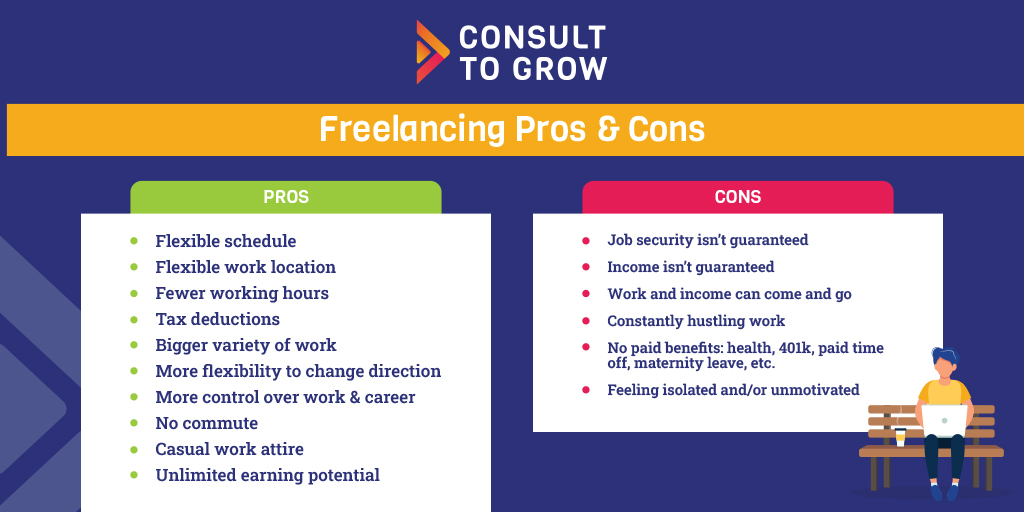
Avoid Freelancer Scams
Especially when finding contract jobs online, it’s important to be concerned about scams that will take advantage of your time and potentially cause you to lose (not make) money. Here are a few signs of scams that can help you save time and avoid liability:
- Avoid jobs that sound too good to be true. For example, if a job promises to pay a large amount of money for very little work, it’s probably too good to be true.
- Avoid jobs that ask for your person financial information upfront. Do not share your social security number, bank account, home address, date of birth, etc. until you know for sure the source is trusted.
Look for red flags and proceed cautiously.
- Does the job ad have glaring grammatical or spelling errors?
- Is the contact email address personal or one that mimics a real company?
- Is someone requesting you pay them some money to make a deal happen?
- Is someone offering you a job without verifying your experience or background?
- Does the client offer to pay you in something other than money (like products)?
- Is the client making an illegal or immoral request?
Getting Set Up
Decide where you’re going to work. If you need working space, decide where you want to work from: home office, space provided by a client or rent space within a co-working space like WeWork. Balance your need for productive working space against the cost of renting space. If you spend $700 renting office space each month and charge $100 for your services, you’ll have to work 8-10 hours each month (depending on your profit margins) to cover that expense. Before you sign a short or long-term lease, make sure the investment is worth it.
Make a list and purchase the tools & equipment you need to do your work. Different freelancers and consultants will need different tools and equipment to do their job properly. Think about the equipment, software, supplies and resources you’ll need to be successful. Whenever possible, go with lightly used or free options to save up front money.
Here’s a list of the tools I’ve purchased in running my independent consulting business. Use this list as a guide only – buy the things you need for your business within your startup budget. With companies like Amazon shipping within 24 hours, buy new supplies and equipment as needed rather than buying upfront and never using them.
Office Furniture
- Desk: Sturdy and spacious enough to accommodate your computer, peripherals, and other work materials.
- Chair: Ergonomic office chair for comfortable, long hours of sitting.
- Bookshelves: For storing books, reference materials, and personal items.
- Lighting: Desk lamp and general room lighting that is bright and reduces eye strain.
Technology and Electronics
- Computer: High-performance desktop or laptop, depending on your needs.
- Monitor: At least one high-resolution monitor; consider dual monitors for increased productivity.
- Printer/Scanner: All-in-one printer with scanning, copying, and faxing capabilities.
- Webcam: High-quality webcam for video calls and virtual meetings.
- External Hard Drive: For backup and extra storage.
- UPS (Uninterruptible Power Supply): To protect against power outages and surges.
Networking
- Router: Reliable, high-speed internet router.
- Ethernet Cables: For a stable wired internet connection.
- Wi-Fi Extender: If you need to boost your internet signal.
Office Supplies
- Notebooks: For jotting down ideas and notes.
- Pens/Pencils: A variety of writing instruments.
- Paper: Printer paper, sticky notes, and other types of paper.
- Organizers: Desk organizers for pens, documents, and other small items.
- Whiteboard/Notice Board: For planning and visual organization.
- Calendar/Planner: To keep track of deadlines and appointments.
Download the Office Supply Checklist now.
Miscellaneous
- Shredder: For securely disposing of sensitive documents.
- Label Maker: To help organize and identify items.
- Cable Management: Clips, ties, and sleeves to keep cords tidy.
- Cleaning Supplies: Microfiber cloths, screen cleaners, and disinfecting wipes for your workspace and equipment.
Making Plans & Setting Goals
It’s important to be clear about your near-term goals, sharpen your market focus and know your industry and customer.
Here’s what’s covered in this post:
- Clarifying why you want to become a freelancer of independent consultant.
- Setting specific six and 12-month goals for your career.
- Establishing a market & industry focus.
- Understand the customer you want to approach and their buying habits.
- Making a safe transition from your current work situation.
In three to six months look back at your answers to the questions here and check and adjust. Are you meeting your goals? Are the services you’re offering different than what you planned? Don’t let fear of failure you keep you from starting your own business or adjusting your plans as you discover new things about yourself, your clients and the work you’re doing.
Marshalling Resources
Satisfying Requirements
This is the boring, but necessary, legal part of becoming a freelancer or independent consultant. Take care of of these necessary first steps to avoid critical issues later.
This is also a good place to remind you that Gig Startup Fundamentals wasn’t developed by a lawyer, CPA or financial advisor. If you have critical legal and financial questions, be sure to consult a licensed advisor familiar with your business and local laws.
Business Registration
You’ll need to decide if you want to operate as a sole proprietorship (SP), limited liability company (LLC) or something else. There are other types of legal entities but these two are the most common for freelancers and independent consultants.
Going the Sole Proprietorship Route
A sole proprietorship is simpler and requires the least amount of tax paperwork. With an SP, you don’t need a separate business tax return. It’s best for freelancers who occasionally take on small projects with limited liability. In the case of a sole proprietorship, your tax ID number will be your social security number and your warranty will be your name.
If you want to name your business anything other than your given name as a sole proprietor, then you’ll need to register a “Doing Business As” name with the state, county or city you are located in. Doing Business As registrations can also be known as a trade name, fictitious name, or assumed name registrations.
Organizing Your Business as a Legal Entity
Serious freelancers with regular contracts or doing bigger projects with large organizations should consider doing business as a legal entity like a limited liability company. A legal entity can shield freelancers from personal liability. More importantly, a legally organized business can build legitimacy for your business.
Legally entities are for the very serious freelancer – they are more expensive to setup and require more paperwork. You can do this (i) through a paid service like Legal Zoom, (ii) by hiring a local & independent lawyer to help, or (iii) by contacting your Secretary of State to obtain Articles of Organization, forms, and fee schedules for filling on your own.
If you’re still not sure, the Small Business Administration also has some helpful resources to help you choose a business structure appropriate for your small business.
Business Licenses
In most cities and states, you need the government’s approval to operate. In some cases, you will need a specialty license from a state licensing board to do business (contractors, massage therapists, notaries, etc.). Local licensing requirements often depend on what kind of services you offer, who you employ, where you live, where you operate and if you employ other people.
Consider calling a local or state chamber of commerce office to see if they have a “Business Startup Kit” that will help you satisfy local requirements. Your state comptroller or economic development agency might also have good resources. If all else fails, do an online search for “How to start a business in [insert your city or state]?”
If you are concerned about getting this step right, consider investing in a service like Business Licenses that can do the leg work for you (just be warned – the Business Licenses website will try to sell or cross sell you many other products and services useful to starting your business; they also charge for their services).
Freelance Contract
Regardless of your specialization, you need to send and sign agreements upfront before you do any work. Written agreements not only provide you some protection if things don’t work out the way you or the client hoped but they also help you set expectations and answer critical questions best resolved before work begins.
The agreement you use can be as simple or sophisticated as the job & client requires but should address:
- Who is doing business with who
- Who is responsible for what
- What services are being offered and a clearly defined scope of work
- Timeline and deliverables
- The rates of payment or cost of the project
- Who pays for what expenses
- Who retains ownership of work, if applicable
- Any upfront deposits or retainers and/or milestone payments
- Terms for ending the relationship
- Terms for late payment
Don’t worry, we’ve provided some sample contract templates we like for you to reference in the Tools & Templates section. Make sure you use a contract that is relevant to your situation. Since we’re not lawyers, you might have your own lawyer review the contract you decide to use.
If sample contracts we provide don’t meet your needs, search online for open sourced templates that might be more specific to the services you’re providing. I occasionally also use Law Depot’s templates.
Business Insurance
As an independent contractor or freelancer, you are in business for yourself. The people who hire you are your clients and their insurance likely won’t cover you. Sometimes, clients (especially very large ones) require you to have your own insurance before you can begin work. If a client requires you to buy a business insurance you don’t already have, consider negotiating the cost of that insurance into the price of your work.
Depending on the type of freelance work you do, you might consider one or more of the following types of business insurance:
- Property Insurance. If you own commercial property or expensive equipment, property insurance may be a worthwhile investment. It pays to repair or replace assets damaged by certain events, such as fire or theft. If you’re working from home, you may be able to use your homeowner’s or renter’s insurance policy here – just make sure the insurance company knows about your high value equipment and will cover it if a loss occurs.
- Professional Liability Insurance. Also called Errors and Omissions, this policy covers legal expenses when a client claims your negligence caused financial losses.
- General Liability Insurance. This policy kicks in when someone seeks compensation for a bodily injury they suffered on your premises or property damage caused by your work. It may also cover claims of slander, libel, or copyright infringement.
- Business Owner’s Policy. Also referred to as a BOP. This is typically a bundled insurance product consisting of both General Liability and Property Insurance.
In all cases, you will have to buy insurance through a broker. Either reach out to an insurance agent/broker you know and trust locally or search online for a competent broker who can sell policies virtually.
If you work with a local insurance agent or broker, take the opportunity to announce you’re offering your skills as a service and see if they know anyone who might need help in the community.
Building Your Professional Network
One of the many assets you can leverage to start your own freelance or independent consulting business is your own personal and professional network. Use this simple three step process to collect, contact and grow your professional network for new clients and work.
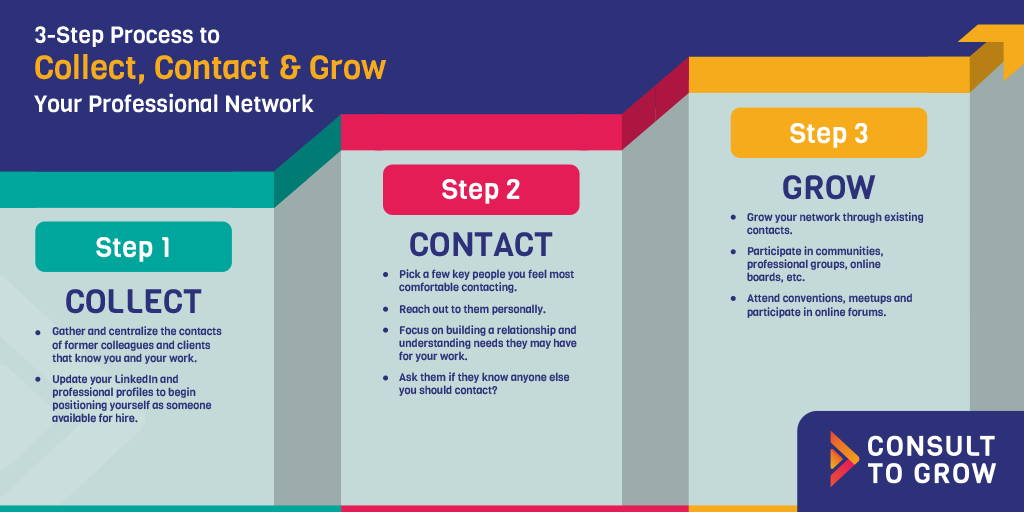
A few words of caution:
- Reach out to your network thoughtfully and with a light touch to avoid annoying a potential client.
- If you’re leaving a job where you signed any non-compete and/or non-solicitation agreements, be sure to respect and follow those.
Setting Rates & Handling Money
Estimating Startup Costs
Avoid the common misconception that the cost of starting and running a freelance business is free –it’s not! It is true that freelancers and independent consultants often have lower startup costs than brick and mortar business, but nearly all freelancers have some costs to get started.
We want you to go into your new venture with your eyes wide-open about the cost of doing business as a freelancer and we’ve put together a comprehensive list of potential expenses you may occur. These expenses are broken into three big buckets:
- Fixed & Startup Costs. These are typically one time or occasional costs of starting and running your business such as buying furniture and equipment. We cover many fixed and startup expenses in the Startup Budget tool.
- Borrowing Costs. If you are unable to fully fund the cost of starting your own freelance business, you might borrow some or all the needed money through a small business or bank loan, friends & family or even through credit card debt financing. Our Startup Budget tool helps you plan to pay that money back within 12 months.
- Variable Costs of Doing Business. These are costs that are incurred on a regular basis which you might not think about like monthly cellular phone bills, internet charges, web hosting and more. We cover many of these in the Rate Setting tool.
- The Self Employment Costs. These are costs you are likely used to your employer paying or contributing to like health insurance and employment taxes. We cover many of these in the Personal Budget tool.
Setting Rates
Hourly Rate Setting
How to set hourly rates is probably one of the top questions freelancers and independent consultants have.
Ultimately, you want a rate the does three things:
- covers business expenses & taxes allowing you enough income to afford your life,
- motivates you to trade your time in exchange for doing work, and
- to be within the range of what clients are willing to pay to outsource to you.

To set your rate, I highly recommend you complete the Startup Budget and Personal Expense Budget. Both will offer practical insights into how much income you need to survive and thrive as a freelancer or independent consultant. With each budget complete, you can complete the Rate Setter Tool spreadsheet provided. This tool covers four major areas of setting your rate:
- How many billable and non-billable hours will you work in a year?
- What annual operating costs will you incur and need to pass on to clients?
- How much income do you want to make before taxes?
- A reality check on the estimated daily & hourly rates to market rates.
If you feel the Rate Setting Tool is too complex, a simple alternative is to take your current hourly rate and multiply the hourly rate by 2. If you’re paid an annual salary, you can calculate your hourly rate by dividing your annual salary by 2080.
Here’s an example:
- Jamal is an administrative assistant making $38,000.
- He wants to freelance on the side helping people with administrative tasks.
- His hourly rate is $38,000 divide by 2080 or $18.26.
- He would outsource his time for about $36 per hour.
- If you visit Upwork, you’ll see virtual assistants charge between $20 to $35 per hour.
- Jamal will need to fall within that range unless he has some specialized skills.
Don’t forget that you’ll also need to pay self-employment taxes – this is covered more thoroughly in the section Making Financial Plans for Taxes.
Hourly Rates vs. Per Project
There is no right or wrong answer to the question of billing your clients on an hourly rate basis, per project basis or a mixture of the two. It may depend on your preferences, your client’s preferences or standard practices for the services you are offering.
As an entrepreneur, it’s important to be flexible with your pricing. Sometimes we charge clients by the hour or by the project. Other times, we will set an hourly rate with a not-to-exceed maximum value. It depends on the work, the project and the client.
We like hourly rates because we get paid in direct proportion to the work we do. When you charge hourly rates consider the following:
- It’s a straightforward ratio for work to pay.
- You’ll be responsible for keeping track of and reporting your hours.
- Clients may balk at hourly rates on the high end of the market.
- Clients may feel you’re working slowly to rack up hours.
- There is less reward for you to work efficiently.
Clients typically like per project fees because it contains the price for the work and is easier to compare price to value of the deliverable. When you charge per project or flat fee rates, consider the following:
- Setting and maintain the scope of work is very important. Scope creep happens often and will need to be managed over time.
- Carefully estimate the amount of time to deliver the work and then give yourself a buffer. Keep in mind, if you’re wrong about how much time a well scoped project will take, you’ll be out of luck. If you overestimate the time a project will take, you might send a proposal to the client that’s “too high” and lose the work.
- Per project and flat fee rates can be good for freelancers and independent consultants because this fee structure takes away the stress of tracking hours and minutes and incentivizes you to work more smartly and efficiently.
You can also create a hybrid method of charging by setting a base price and then letting the client know that you will charge a specific hourly rate for specific work (conducting interviews, extra coaching sessions, etc.)
Keep careful track of your billable hours with online tools such as Freshbooks Cloud Accounting. Freshbooks
offers:
-
- 30 day free trial. $180 per year for 5 or fewer billable clients.
- As a consultant, Freshbooks makes keeping track of clients, projects, time, expenses and invoices super easy.
- The solution is easy-to-use, has powerful tools & features, and is completely cloud based.
Reasons for Higher Rates
There are certain situations where you should consider charging your clients above-market rates:
- Time is of the essence for the client. Clients understand that time is money and often will pay higher rates for freelancers and consultants who can offer quick turnarounds or meet seemingly impossible deadlines. If a Client is requesting work that will cause you to delay other clients or work 20-hour days, consider charging a higher rate for the convenience.
- Clients want to book 100% or more of your billable time. It’s good to be in demand, but when a client books 100% of your time, they are making you unavailable to other clients and limiting your ability to diversify your portfolio. In fact, you might lose clients who find other freelancers when you’re not available.
- Projects that create huge financial rewards for the client. Consider the value of the project to the client for the project. If you’re a consultant helping a client turn around an underperforming location, consider charging more than when you are doing administrative or research work with a low return on investment for them.
To help you further, review the following together to determine your costs so that you can better establish rates that will produce net benefits.
Financial Tools: Budgeting & Rate Setting
Collecting Payments from Clients
Collecting payments on time is crucial for maintaining a healthy cash flow and ensuring the sustainability of your freelance business. Delayed payments can disrupt your financial planning, impact your ability to pay bills, and cause unnecessary stress. To collect payments the right way, establish clear payment terms in your contracts, including due dates, late fees, and preferred payment methods. Send invoices promptly and include all necessary details such as the services provided, the agreed-upon amount, and payment instructions. It will help greatly if you identify the client’s accountant and carbon copy them on any invoices you send to the client’s company. Follow up with clients shortly before the due date as a gentle reminder, and maintain a professional yet firm tone when addressing overdue payments. Using invoicing software (we use Freshbooks) can streamline this process, helping you track payments and send automated reminders. Being proactive and consistent with your payment collection practices will reinforce your professionalism and ensure that you are compensated fairly and timely for your work.
Experiment with different invoicing systems to determine what works best for you. Try
In this vein, here’s a starter pack of client agreements to help assure you and your client are on the same page about what is being offered and what is expected:
Client Agreements
- Simple Sample Service Agreement
- Sample Contract for a Killer Website
- Sample Mutual Non-Disclosure Agreement
Making Financial Plans for Taxes
Plan for Paying Estimated Taxes. This often comes as a surprise to freelancers, who may be used to having their taxes withheld by an employer. As a freelancer, it’s your responsibility to pay the Internal Revenue Service and your state revenue agency almost as soon as you earn income each quarter. If you expect to owe $1,000 or more when you file your annual return, then you must pay estimated taxes on income. I pay estimated taxes quarterly.
For every dollar you make, put at least 25-30% away for business taxes. Think of this as you would think of your employer withholding taxes in your paycheck. If you’re not sure how much to save, search the Internet for “Self-Employment Tax Calculator” to get a better idea of how much you might owe.
If self-employment is a fulltime role for you, it may be worth exploring how an S-Corp can reduce your self-employment taxes. This topic is fairly covered in this post on Intuit’s website.
It’s always advisable to consult with a tax professional who can help you determine a more precise percentage based on your specific situation and projected income. Regularly reviewing your earnings and adjusting your estimated tax payments quarterly can help you stay on track and avoid underpayment penalties.
Complete a W9 Form for New Clients. When you sign a contract or start work with a new client, it’s likely they will ask you to complete IRS Form W-9. Filling out a W-9 is straightforward: provide your name and social security number or Federal Tax ID Number, or “Doing Business As” name. The client holds this form and doesn’t send it to the IRS; it’s a formal certification by you that your tax ID (SSN) is correct.
Receiving the 1099 Form. If you’ve earned $600 or more in a year from a client in non-employment income, the client must report these payments to the IRS through Form 1099-Misc. Your client will send you a copy by the end of January each year. Be sure the amount the client stated they paid you matches your records. You don’t have to do anything with the form other than keep it in your records and use it as a reference when you report your annual income to the IRS. Think of it as the freelancer’s equivalent of the W-2 form.
Keep Track of Your Deductions. The most consequential tax benefit for freelancers is the deductions you are eligible to receive. Tax Deductions include (but aren’t limited to): Expenses associated with having a home office, a computer, health insurance, professional development courses or certifications, and even unpaid invoices. Here’s a more complete list of deductions. For all expenses, try to keep immaculate records. Storing and organizing all receipts is a must. Use this Business Income and Expense Spreadsheet for Schedule C to help you along.

Getting Clients
Announcing Your Availability
If you continue to follow the three-step process described in the section Building Your Professional Network, you should have a few leads to begin the process of announcing your availability. Let the world know you’re open for business through an email message, social media accounts (LinkedIn, Facebook, X, BlueSky, etc.), and listing yourself in professional directories related to your skill and location.
Preparing a Portfolio
When it comes to creating credibility as a freelancer or independent consultant, it’s important to show and tell. No matter your intent, a presentation or website that showcases the best of you and your work will help you attract new customers, give clients a feel for your skill and experience, and enhance your professional persona.
Here are a few things you want to be sure to do when you create a portfolio:
- Inspire Trust. Show the prospective client they can trust you and your work?
- Leverage Past Work. Showcase your work through illustrations and case studies.
- Before & After Illustrations. Illustrate your ability to transform and create.
- Show a Record of Success. Show and tell your track record of success
Include as many of the following elements as you can on your website and in your portfolio:
- An introduction to you and your work.
- Your resume, current vita or professional bio.
- A description of the services and skills you offer.
- A description of your target industry and ideal customer.
- Two different pictures of yourself so the clients know you’re a human.
- A story – people love stories they show purpose and success.
- A list of clients and testimonials about your work from two or three of them.
- Make it easy to contact you.
As a startup, you may be missing some of the above elements. Don’t worry. Ask potential clients to do work as both an introduction and an opportunity to create a sample of your work. This approach can be a great way to find new business and create portfolio material. You might also reach out to friends & family or people in your professional network to create illustrations of your work or to serve as references for you professionally. If all else fails, create mockups of your work.
Keep in mind that sometimes you have agreements in place with clients that require you to keep your work with them confidential. Some clients even require that you not share that they are a client. Many times, you can get around this by generically describing the client – for example, as a “Fortune 500 consumer brand.”

Creating a Website
Having a professional website, the sells you and your services can be a great way to grow your business and establish yourself as a serious freelancer or consultant. With just a small amount of tech savvy, you can build your own website in under a day.
- Pick a host. We’ve used Weebly and Dreamhost with great success but other companies like Wix, Squarespace and Bluehost are also popular and easy to use providers. Each of these companies has pros and cons. As a startup, focus on functionality, price and features. This site is hosted on Dreamhost and uses WordPress.
- Know your keywords. If you want a website that drives traffic, you’ll want to select some key words that your client would use to describe and find your business. For example, “restaurant consultant,” “web design company,” “freelance travel writer,” etc. Use these key words in headings and copy on your website.
- Choose a domain. It’s worth investing in your own domain (www.consulttogrow.com for us) instead of using a free subdomain. What domain you choose will depend on what’s available but something short and easy to remember based on your own name, the name of your business, or the keywords from above are great places to start. Try to get a .com extension and avoid special characters like hypens (-) and (_) underscores. Keep it simple!
- Setup the Site. Once you have a host, keywords and domain ideas, you’ll be ready to setup your site. If you’re timid about the process, visit YouTube and find a video that walks you through the process for the specific host you’ve selected.
- Make it your own. Thinking like a client, decide what content needs to be shared and how it should be presented. If you’re not sure, search your competitors online and look at how they’re selling their services. Leverage the tips and insights in the Preparing a Portfolio section; but remember the goal of your website is to get people to contact you.
If you invest time and money into a website for your small business, make sure it sells and converts visitors into customers.
- Invite visitors to engage with you through LinkedIn, Facebook or other networks.
- Ask for email addresses to join your newsletter for future contact.
- Offer an option to “book now” for consultations or coaching sessions.
Finding Work Through Online Agencies
Obtaining work through your professional network will be the best place for you to build a client portfolio. Your connections are warm leads who know you and the quality of your work.
If you’re new to freelancing or have a limited network, you might find obtaining freelancing work online is a good way to earn money on the side, get your foot in the door with prospective clients, and build up your portfolio of work for future prospective clients
Online agencies won’t necessarily offer financial security but can be a stepping stone to establishing yourself and proving your skills as a freelancer. While there are many online freelance communities, the most popular freelance sites are Freelancer.com, Fiverr, Upwork, and goLance.
Here’s how the sites typically work with some variances:
- You will be asked to create a profile describing your skills and experience, job history and share your portfolio for clients.
- Sometimes clients approach you for work and other times you must “bid” on work.
- Clients post job listings detailing their scope of work and what they’re looking for in a freelancer.
- Freelancers (that’s you!) then submit proposals for projects they are interested in doing for client review.
- Clients then choose the freelancer proposal that best fits their project and place project funding in escrow.
- The whole project is managed through the online system.
- Even on these sites, be wary of scammers who try to move you away from the online system. Tips avoiding scams are covered in the above section entitled Avoiding Scams.
What site or sites works best for you may depend on your skills and the type of projects you want to take on as a freelancer. Do online research on the pros and cons of each site for the type of services you’re offering before you sign up.
As you consider joining the platforms, carefully consider how each site approaches the following:
- Proactive vs. Passive Sales Approach. Some sites allow you to post your profile and projects to take a wait and see approach (Fiverr) while others (Upwork & Freelancer) require you to hunt work and submit proposals all the time.
- Fee Structures. Clearly understand the fee structure. Each site has its own fee structure for freelancers and clients. Typically, the fee is somewhere between 10% to 20% of the work. Sometimes fees vary for “preferred projects.” Some sites have monthly fees and others do not.
- Bidding System. Each site will provide you a limited number of connections, bids or gigs. If you want to bid on more than your allocated number, you must pay more or earn more through your work.
These online freelance communities can also be a great place to find online freelancers who can help you deliver services to clients. For example, we have an ongoing relationship through Upwork with a freelancer in Thailand who helps refine PowerPoint files for consulting clients – contact us if you want her name!
Choosing Between Two Assignments
As you grow your business, you may be faced with two projects that compete for your time. How you choose will depend on what’s important to you:
- Security: Which project offers you the most financial security. Projects offering full-time work, with your established clients, and reliable pay would be higher priority.
- Variety: Which project offers you the opportunity to expand your client base, learn new skills, work in a new environment or helps you freshen up your skills?
- Success: Which projects most closely aligns to the goals you set the The Freelance Fundamentals Workbook for 6 months and 12 months? This is a values-based decision based on what is in your best interest in the longer view.
Doing the Work
Preparing a Proposal
You’ve found a perspective client; you have had detailed discussions about their needs and now is your chance to seal the deal and bring in new business. While it may seem administrative, consider your proposal a part of your marketing to get and keep new business.
Great proposals will:
- Help you win more jobs
- Create clarity for you & the client about roles, goals and outcomes of the project
- Sell you as the best person to solve the client’s problem
Here are a few things to cover in your proposal:
- Summarize what you know from the client
- Describe how you’re going to solve the client’s project
- Establish mutual commitments & expectations
- Divide the work into manageable phases, if appropriate
- Describe what will be delivered to the client
- Show the client relevant samples of your work
- Describe your fees and the proposed timeline.
- Describe how your experience & skills best fits solving the client’s problem.
- Request everything you need from the client to get started.

Proposals can be emailed, submitted through popular freelance sites or sent over in document or presentation format. We’ve included a few proposal templates to help you get started and win more work in the Tools and Templates section.
Onboarding Clients
Once you get work, it is important to set yourself and the client up for a successful relationship. This process likely started in negotiating your contract with the client.
- Be clear on what the client expects from you: services, scope, deliverables, etc.
- Set some expectations for the client:
- Request a single point of contact & contact information.
- Request access to required subject matter experts and decision makers.
- Clarify your needs: interviews, data, style requirements, etc.
- Set some guidelines around responsiveness and request the client do the same.
- “ie: You can expect me to respond within 24 hours of receiving your messages.”
Interacting with Clients
The best form of marketing any freelancer or independent consultant will have is very satisfied clients who would recommend you to others. Make sure you carefully nurture your relationship with clients and deliver quality work.
- Get to know your client and their business before the first meeting by viewing their website, LinkedIn profile, recent articles and through other public sources.
- Listen to your client carefully and repeat back to them what you heard them say through conversation or a recap email message to assure you are aligned.
- Try to fit your work to the client’s style and culture. Larger companies may have a “style guide” with preferred fonts, colors, etc. With smaller companies, ask for a few samples of internal documents which might give insight on culture and style.
The more you do these three things, the more clients will feel like you are an extension of their team. Adapting to your client will build deeper connections and improve the likelihood of repeat business.
Delivering Quality Work
Your success as a freelancer or independent consultant will be directly related to the quality of your work. Use these three steps to maximize your success:
- Create value. Does your work exceed their expectations and solve their problem by the agreed upon deadline?
- Be transparent. Do your work well; then help them understand what you did to get to the deliverable. Sometimes clients underestimate the time & effort deliverables require.
- Confirm, deliver, check & adjust. Confirm the task(s), deliver on what’s being requested, review what has been provided and ask for feedback to improve.
At the end of projects or engagements, do a quick reality check:
- Did you deliver exactly what the client requested?
- Did your work product create value for the client?
- Did you provide the document in the client’s style?
Finally, empower the client to close out the project.
Have the client confirm that you have successfully completed the work and met or exceeded their expectations in writing (via email or within a freelance system).
Remember, as a freelancer or independent consultant, your work is your brand. The only way to grow your business is to deliver on your promise to the client and create value.
Requesting Recommendations and Referrals
Recommendations. Don’t miss an opportunity to get a referral or recommendation from a client. If the client is fully satisfied, ask them for a quote about your work that can be attributed to the client and their company. Sometimes individuals or big companies don’t want their name listed… if that’s the case, ask if they would be comfortable with a generic attribution like “Senior Director, Large Telecommunications Company”.
Referrals. If it feels right, ask the client if they know anyone you should speak to about the services you provide. If so, ask if they would provide a mutual introduction. If not, ask if they would be willing to share contact information for a referral and allow you to reach out directly to the new lead.
Managing Time
Creating Schedules
Establishing a routine as a freelancer or independent consultant was one of the hardest things we had to do. If you haven’t worked from home before, you might not know how hard Netflix & Hulu will call your name when you work from home!
Take a moment to create a game plan for how you want to setup your schedule each week. We promise, you will be 5x to 10x more productive if you plan out your workdays and workweek.
Only you know how you work best, but consider the following:
- Keep a “get up and go to the office” mindset regardless of your office location.
- Decide your work week schedule. What days will you work and on what?
- Decide your work hours. Think about your personal life and client time zones.
- Set times to eat lunch, take personal breaks and workout.
- Know what tasks and deliverables are due by when.
You can find a well written resource on How to Craft the Perfect Schedule as a Work From Home Freelancer online here.
Adopting Time-Management Tools
Carefully tracking your time is important for you and your clients. Even when you are working flat fee projects, tracking time helps you understand the amount of your own resources invested into a project and your overall productivity doing client work for future proposals and estimates.
Choose a tool that best suits you:
- Note time directly in a word document or spreadsheet invoice.
- Use a plain timesheet in a word document or spreadsheet.
- Use a time tracking, invoicing and accounting tool like Freshbooks
It is also okay to turn off the clock for “me time!” Consider your personal life like it is a client and schedule set time you, your friends & family.
Deconstructing Big Jobs
Large jobs and projects should be broken down into smaller phases to help you and your client map out doing the work and meet manageable deadlines.
Breaking down projects into major milestones and the sub-tasks that need to be completed to reach those milestones will help you see a road map to delivering large projects in major buckets. Be sure to write down the major milestones and tasks that go with each one.
Think about your work habits, productivity and competing work. Get feedback from the client on reasonable timelines for getting feedback and approvals. Based on those factors, begin laying out a timeline between now and when the project will be due that is practical and realistic.
If you’re breaking down a project into phases or milestones, be sure to do this before the contract is signed. Be clear about what you need from the client to stay on track. And, also note how time delays and cost overruns will be handled should they arise (and they often do!)
Keeping Your Business Healthy
Staying Motivated
It is easy to get stuck in a rut when you work solo. Losing motivation can even be a problem for the most successful freelancers and independent consultants. Being aware of the feeling is as important as acting to reignite your motivation.
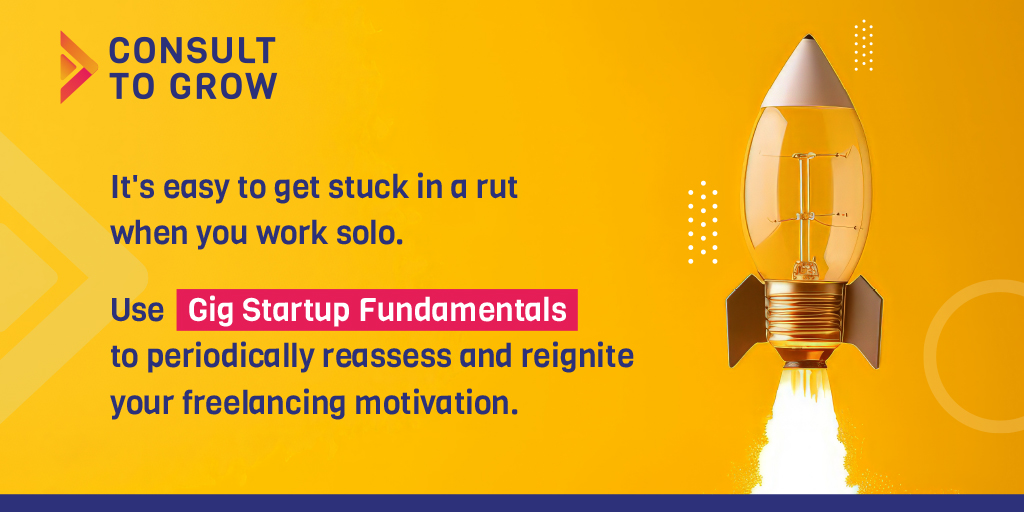
- Do you remember “why” you’re freelancing?
- Go back to the Freelance Fundamentals Workbook
- Remind yourself why you started this journey
- Check in on your goals and see how you’re progressing
- Are you following our advice to maintain your routine?
- Are you following a work schedule?
- Are you working from your designated workspace (and not a bed or couch!?)
- Are you aware that motivation isn’t instant, it builds over time?
- You can’t go from unmotivated to motivated in seconds.
- Stop procrastinating, stay focused, and complete some key tasks.
- Find inspiration and socialize with other people.
- Are you maintaining your physical health?
- Are you exercising or going for a walk to find your energy for the day?
- Are you eating healthy food that gives you energy?
- It is okay to evolve and change your goals if something isn’t working:
- Has your work experiences changed your goals?
- Has your feelings about work and clients changed your goals?
If you’re not making enough money or you feel freelancing isn’t for you, pause and take a deep breath. It’s okay to make pivots but do so safely for yourself and your family. Find a friend, mentor or coach and talk through what’s happening to make a thoughtful and safe next step decision.
Growing Through Hires and Partnerships
As your freelance or independent business becomes more successful, you will realize that businesses based on the skills and experience of a single human don’t scale – your time is finite. If you’re feeling overworked or having to decline work due to time constraints, consider one of these three ways to leverage new resources and create more income:
- Leverage an assistant and outside resources. Offload administrative work and small tasks which aren’t your specialty to an assistant (virtual or real life) and other contractors. We routinely save time and client’s money by outsourcing administrative tasks, graphic design work and presentation formatting to other freelancers!
- Hire an associate. Add an associate to your small business who can bring added skills, capabilities, range and collaboration to your work. Any time you add an associate, you should do so carefully fully understanding the financial risk. Keep in mind, you will need to oversee their work and you will lose control over details of the work they assume responsibility for.
- Partner with another Professional. Adding a Partner brings similar value to your small business as an associate, but at a higher level. You should expect a partner to bring higher level skills, a broader network, and more ability to attract bigger clients. While you likely won’t be responsible for paying them a salary, you will need to share the profits of your business and that comes with complex agreements, deeper levels of trust between you and the new partner in your business, and new relationship-related headaches.
Building Passive Income
Building a name for yourself as a freelancer, independent consultant and subject matter expert who creates real value for clients should be your first priority. Once your core business is in place and flourishing, you can begin thinking about building passive income for your business through:
- Royalties from writing books, creating stock images, publishing e-books and guides.
- Commissions from affiliate and resale programs.
- Direct selling products to your clients like courses, templates, tools, etc.

You will find these spread out through the post, but we’ve gathered them here for your ease of use.
Financial Tools: Budgeting & Rate Setting
Client Agreements
- Simple Sample Service Agreement
- Sample Contract for a Killer Website
- Sample Mutual Non-Disclosure Agreement
Services
- Freshbooks Cloud Accounting
- 30 day free trial. $180 per year for 5 or fewer billable clients.
- As a consultant, Freshbooks makes keeping track of clients, projects, time, expenses and invoices super easy.
- The solution is easy-to-use, has powerful tools & features, and is completely cloud based.
Other Tools & Templates



